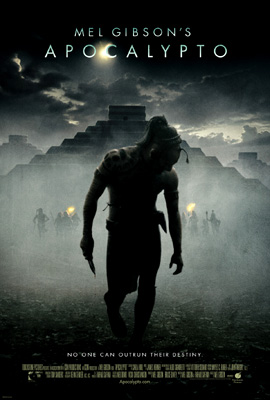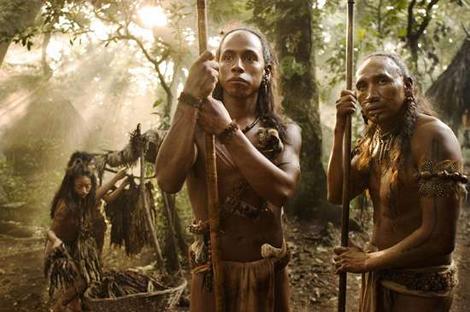 Mel Gibson's epic movie, 'Apocalypto', is already four years old. However, for many visitors to Mexico, this movie is their only source of knowledge about the Maya people. Many tourists point at the steps of real-life structures like El Castillo, then start referencing a particularly graphic scene from 'Apocalypto'. It is clearly time to explore this award-winning blockbuster, with regard to the real-life Maya.
Mel Gibson's epic movie, 'Apocalypto', is already four years old. However, for many visitors to Mexico, this movie is their only source of knowledge about the Maya people. Many tourists point at the steps of real-life structures like El Castillo, then start referencing a particularly graphic scene from 'Apocalypto'. It is clearly time to explore this award-winning blockbuster, with regard to the real-life Maya. 'Apocalypto' is a chase flick, in the action-adventure genre, played out against the lush jungle setting of the late Classic Maya civilization. It has a script entirely in the Yucatec Maya language, with subtitles for those not conversant in it. The movie watching public is drawn into a dark and dangerous world, as we follow the fortunes of a young man named Jaguar Paw (Rudy Youngblood). We watch endemic sadism, as captors torture slaves; wars run bloody; wholesale human sacrifice is practiced; and even friends are left in the jungle to die alone.
Synopsis
Jaguar Paw lives in a Maya hunting community, deep within the Yucatán jungle; but the village is raided and its adult population is taken to a Maya city. Here the people are sick and starving; while the captives are enslaved or sacrificed in horrific, public ceremonies. However, Jaguar Paw had time, before being captured, to hide his pregnant wife, Seven (Dalia Hernández), and child, Turtles Run (Carlos Emilio Báez) in a well. They have no way of climbing out again, so Jaguar Paw needs to escape in order to rescue them.

This seems hopeless, as he is splayed upon the sacrificial altar, having just witnessed his friends in the same position. Their still-beating hearts were torn from their bodies. They were still conscious, as they were decapitated. (The audience gets the viewpoint from the eyes of a head tumbling down the steep steps, before death finally envelopes the brain.) But the advent of a total eclipse of the sun stills the sacrifices and Jaguar Paw is eventually able to escape via the barbarism of the ballcourt. The entire second part of the movie is the vaunted chase sequence.

Jaguar Paw runs for his life, while the warriors of the ruling Maya king hurtle after him, intent upon his death. He eventually emerges triumphant and saves his wife, child and new-born baby. At the very end, they glimpse the arrival of the Spanish, headed by a Catholic priest, in boats approaching the shore. Jaguar Paw dismisses them as insignificant, despite his wife's suggestion that they may represent their salvation. The whole family walk off into the jungle for a new beginning.
Apocalypto's Themes
The theme is made clear from the Will Durant quotation, in the opening credits, 'A great civilization is not conquered from without until it has destroyed itself from within.' In short, the Maya world was already crumbling into the depths of degradation before the Spanish even conquered them. They were starving in the big cities; their magnificent buildings were in disrepair; their forests were being felled; and humanity was taking so many resources that the environment could no longer sustain them. The revelance to our modern, Western civilization couldn't be more obvious.

Commentators have also noted the underlying Catholic message. Jaguar Paw's wife, Seven, is heavily pregnant, but both she and the baby are endangered. Pro-lifers have seized upon this as an anti-abortion message. Others have stated that the more stark religious statement is that the Maya world was so horrific, that the coming of the Spanish is seen viewed almost with relief. They had a priest prominently placed in the boat, kneeling before a cross. When Seven suggests that her family should go to them, we are all willing Jaguar Paw to agree. He refuses and only historians approve of his decision (as historians know what happens next, namely the death of most of the indigenious population from war and diseases like smallpox). From the point of view of the movie, then the Spanish option would seem the better one.
Is this movie a true, historical depiction of the 16th century Maya?
On balance, the answer would have to be no, it isn't. There are enough broad details and scenery to get a taste of the Maya world; but many of the plot devices are pure fiction or else did happen, but not within Maya civilization. The major argument here is that Mel Gibson wasn't filming a documentary. He was creating an action-adventure movie to entertain theater-goers. But if that same audience is going to treat it as a depiction of true events, then the inaccuracies do need to be ironed out.
* The language isn't 16th century Yucatec Mayan. It's actually modern day Yucatec Mayan, hence there are a lot of Spanish borrow words in it. For example, 'beyora' for 'now' has the Spanish 'hora' in it; while the dog is called 'peco' from the Spanish 'perro'.

* Jaguar Paw's community wouldn't have been hunters living deep in the jungle. In the late Classic period, the Maya were an agricultural people. They did hunt, but rarely, with meat being a luxury meal. The jungle would have all been owned and maintained by a ruler. Even if Jaguar Paw's people lived in the jungle, it would have been in a huge clearing surrounded by fields. They would not have lived in the wilderness of the deep jungle.
* Jaguar Paw's people would have known about the stone cities. Even the most remote Maya village was connected, politically and economically, to a large settlement. There was an extensive road system and the stone cities were plentiful. The local ruler would have not only known about every village in his/her area, but would have had representatives keeping the channels of communication open between all. Supposing that Jaguar Paw had never heard of the city is a little like believing that a modern day person would live in Brooklyn without knowing about Manhattan, or in Etobicoke without suspecting that Toronto existed.
* The Maya women would not have run around bare-chested. Every depiction of the ancient Maya, in books, steles, statues and other carvings shows that they were fully dressed.

* Villages would not have been raided for slaves and sacrificial victims. There was slavery and human-sacrifice in the Maya world, but the victims wouldn't have been the local villagers. They would have been prisoners captured during wars or, even better, the elite from enemy polities. If one ruler could take another ruler, then this heightened his/her prestige. The captured ruler would be publicly humiliated and eventually sacrificed. This would have all happened after a war between the two provinces. It's similar to Saddam Hussein being hanged after the Gulf Wars.
* The Maya did not practice wholesale human sacrifice. The Maya did practice human sacrifice, but not on the industrial scale shown in the movie. The Aztec sacrificed roughly 4,000 people a year; but not the Maya. The Maya people sacrificed a smaller number of people (often just one) less frequently. There were no calendar events requiring it. There is evidence that a human sacrifice happened only in extremity (to end a war) or in the ascension of a new ruler. What was widespread was animal sacrifice or auto-sacrifice (cutting yourself so that your blood falls, but you don't die).
The altar upon which Jaguar Paw is splayed is actually Aztec and was used for that purpose, exactly as depicted. But never by the Maya. They typically threw people into the cenotes with a cord around their necks. The victim then drowned or hanged, whichever happened first.
In short, the sacrificial scene in the movie shows something more akin to the Aztec than the Maya.
* The king wouldn't have just stood by watching the sacrifices. The king acted as High Priest as well. He would have been right in there delivering the speeches and performing the sacrifices. If he hadn't, then he wouldn't have been the divine ruler. The priest would have been.
* The ballcourt wouldn't have been used for 'target practice' on Jaguar Paw and his friends. Even Mel Gibson admitted that this was complete fiction, written in for dramatic tension. It also sets the scene for Jaguar Paw's escape, otherwise it wouldn't have made sense even within the world of the movie. After all, these men could have been better employed as slaves in the lime factories. Therefore I won't bother disputing it, other than to highlight that it didn't happen.
There are many more inaccuracies, but those are some of the main ones.
So we shouldn't watch 'Apocalypto' then?
Please do go ahead! It's a great movie, with some lovely cinematography; though if you hate gore and gratutious violence, then I'd give it a miss. However, it's not a documentary about the Maya. It's a Hollywood movie.
Naturally, if you want to learn all about the true Maya, we'd be happy to welcome you to Mexico!

Chichén Itzá
Various tours, to suit every wallet or time-frame, to the most famous of all the Maya ruins.

Tulum & Xel-Ha All Inclusive
Combine Maya history with natural beauty! Tour the Tulúm ruins, then swim in the Xel Ha natural aquarium.


I know its a movie and its of course fiction, but you cannot say 100% that the Maya did not take remote villagers to use for slaves or sacrifice, or on what scale the sacrifuces were happening. You cannot 100% say that no women went around bare chested or that remote Forrest dwellers did know about the other villagers. You can say "oh well relics and documents prove it." You think living out in the forrest these people would of kept a daily routine on the white board? No.
ReplyDeletespanish arrival llega la civilizacion
ReplyDelete